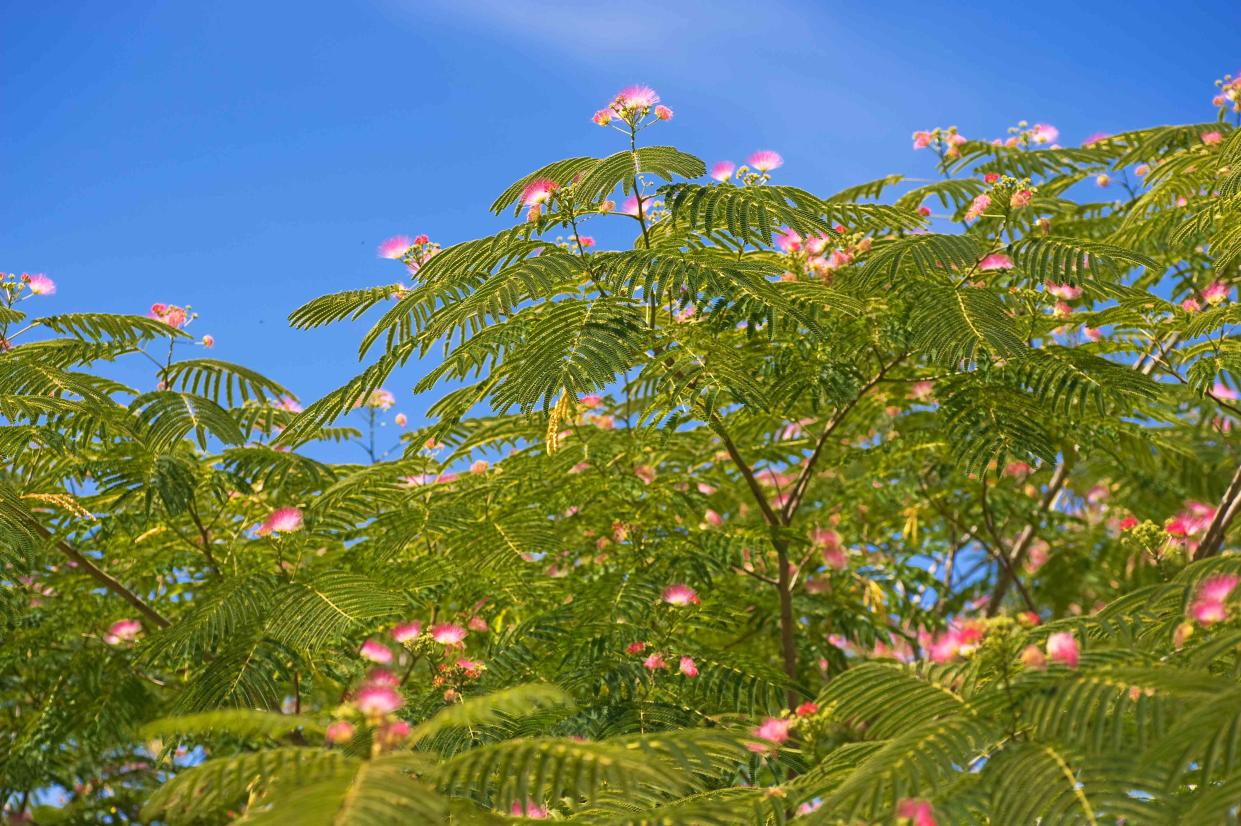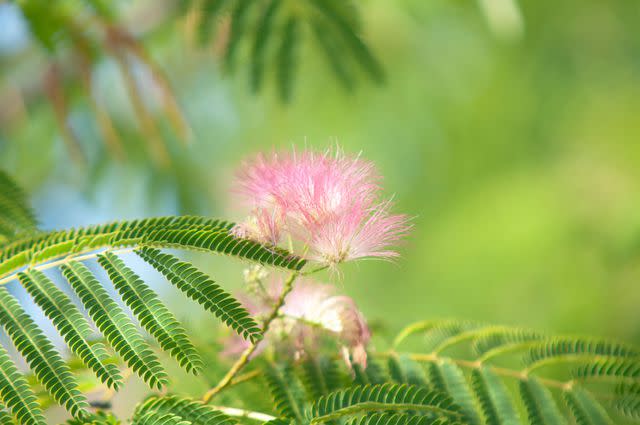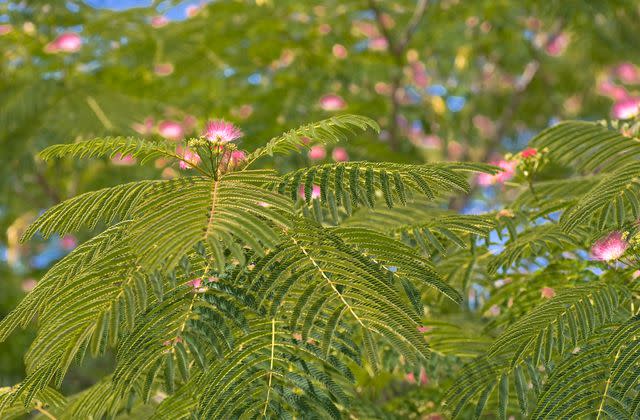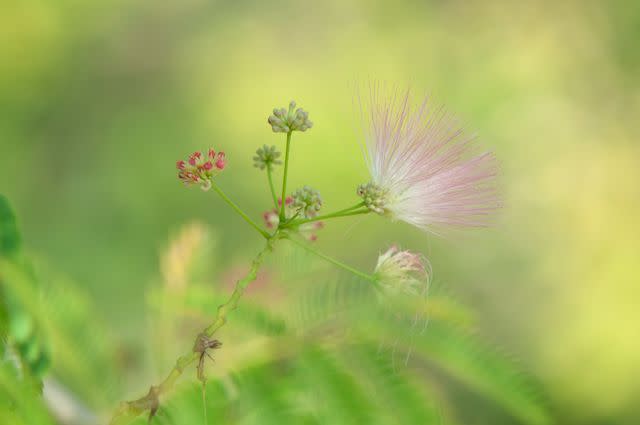How to Grow and Care for Persian Silk Trees

The Spruce / Evgeniya Vlasova
Fact checked by Emily Estep
The Persian silk tree (Albizia julibrissin), features fern-like leaves and exotic-looking flowers but can be considered messy thanks to the dropping seed pods in fall. Plant these fast-growing trees in the spring once the ground has thawed and expect about 3 feet of growth a year. They thrive in a wide range of soils in warm climates and adapt well to both wet and dry conditions. However, take note that some components of the silk tree can be toxic to animals.
Common Name | Persian silk tree, silk tree, pink silk tree, mimosa tree |
Botanical Name | Albizia julibrissin |
Family | Fabaceae |
Plant Type | Tree |
Mature Size | 20-40 ft. tall, 20-50 ft. wide |
Sun Exposure | Full, partial |
Soil Type | Moist but well-drained |
Soil pH | Acidic, neutral, alkaline |
Bloom Time | Summer |
Flower Color | Pink |
Hardiness Zones | 6-9 (USDA) |
Native Area | Middle East, Asia |
Toxicity | Toxic to animals |
Persian Silk Tree Care
The silk tree is a very hardy species tolerant of a wide range of soil and moisture conditions, bolstered by its roots’ ability to fix nitrogen. There's no simpler tree to care once it's established. Here are the main care requirements for getting your Persian silk tree off to a great start.
Plant in full sunlight.
Water weekly while young and getting established.
Plant a distance from structures due to weak wood that breaks easily under ice load and high winds and to prevent unwanted shade.
Add compost at the tree's base to keep nutrients balanced.
Invasive Species
The Persian silk tree is certainly beautiful, but it has to be considered with some caution before planting. If in the Midwest or South, check if it is legal to plant. It is currently listed as invasive in various states. Individual localities may have it in “do not plant” ordinances in other locations. In addition to being invasive, the seeds may be toxic to pets and livestock.

The Spruce / Evgeniya Vlasova

The Spruce / Evgeniya Vlasova

The Spruce / Evgeniya Vlasova
Light
The tree tolerates partial shade but is generally considered intolerant of shade. A. julibrissin will thrive in full sunlight, promoting fuller foliage and abundant flowering.
Soil
The silk tree tolerates a wide range of soil conditions and is even adapted to poor varieties. The tree’s nitrogen-fixing properties allow it to grow well in soils where other plants would suffer.
It can also handle acidic to moderately alkaline soil pH with ease and is a good choice for landscapes that need solutions for high-alkaline areas.
Water
The tree’s habit of naturalizing in wet to dry sites shows that A. julibrissin is adaptable regarding moisture conditions. Giving a young tree that is freshly planted a thorough weekly soaking is essential until the roots have been established. After the first season, no supplemental watering should be needed.
Temperature and Humidity
Though it thrives in the higher temperatures of the southern USDA zones, the silk tree is tolerant of low temperatures. Young plants, however, are frost-tender and will not survive hard winters.
Fertilizer
The silk tree’s profuse growth shows that supplemental feeding is not needed. Compost added at the tree base should be sufficient to replenish nutrients.
Types of Persian Silk Trees
There are numerous cultivars of the silk tree available.
'Ernest Wilson' is a winter-hardy option for northern zones. It has pink and white flowers.
'Rosea' offers bright pink blooms.
'Alba' has pristine white flowers.
'Summer chocolate' features unique, burgundy-color leaves.
Pruning
Prune the tree in fall or winter during its dormant period. If you prune early in the tree's life, you can narrow it to a central trunk, though some prefer to allow it to have several smaller trunks. Regardless of that choice, it's best to prune the top of the tree to a flat shape, then prune back the branches to five or six buds on each. Remove dead, diseased, or weak limbs at any time during the year.
Propagating Persian Silk Tree
Silk tree is easily propagated through seed or cuttings. To propagate through cuttings, take the following steps:
Choose a 6-inch healthy stem in late spring. Choose a branch that has not yet bloomed.
Remove all but the top two or three leaves, dip the stem into water, and then into rooting hormone.
Immediately place the cutting into a 4-inch pot that has been filled with high-quality potting soil.
Place the pot in a plastic bag, then set it in an area of sunny yet indirect light, with a temperature of about 70 degrees Fahrenheit. Keep the soil moist.
Expect roots to grow in three to four weeks.
How to Grow Persian Silk Tree From Seed
Silk trees love to spread seeds, so harvesting them is not difficult. Collect seeds in the fall and store them in a cool, dry place until spring. To grow this tree from seeds, take the following steps:
For the best results, scrape each seed gently with a file or rasp until the hard outer coating is slightly breached.
Place the seeds in an insulated container and pour hot, almost boiling water, over the seeds.
Seal the container and allow them to sit in the hot water for 24 hours.
Dry the seeds and gently press them into the middle of a 3-inch pot filled with compost and perlite in equal amounts. Place the seed one inch deep.
Place the pots outside, preferably against a shady, south-facing wall.
Keep the compost mixture moist. Seeds can take anywhere from seven days to several months to germinate.
When starting as seedlings, it's fine to keep the silk tree in its container until it begins to show roots through the drainage holes. At that point, it's time to transplant the tree to its permanent home in your landscape. When doing this, carefully place them in soil that has been amended with the same type of compost they began growing in.
Potting and Repotting Persian Silk Tree
When repotting a silk tree seedling, choose a container that is at least 4 inches larger than the last pot. As the tree grows, you will need to repot it into a larger pot. If you are potting a larger tree, make sure you choose a container that is twice the size of the root ball. Any container material will do for a Persian silk tree but make sure it has drainage holes. Water weekly because plants in containers typically need more moisture.
Overwintering
This tree can tolerate temperatures down to about 25 degrees Fahrenheit but does much better in areas where the winters aren't as harsh. No matter the zone, make sure your silk tree is planted in full sun and in an area where it is protected from strong winter winds.
Common Pests & Plant Diseases
A variety of insects will feel quite at home in the silk tree, including soft-bodied creatures like mites and mimosa webworms. Cottony cushion scale are also attracted to this tree. Look into insecticidal treatments to help eliminate them.
These trees can also fall victim to fungal disease. Keeping your tree strong by providing optimal care will help prevent fungal growth. Check often for signs of infection such as yellowing leaves and stunted growth.
How to Get Persian Silk Trees to Bloom
The stunning blooms of the Persian silk tree initially drew the attention that inspired the origin of its common name.
Bloom Months
Persian silk trees typically bloom in May or June. The blooms will last several weeks perhaps into August and reappear around the same time the following year.
What Does a Persian Silk Tree's Flowers Look and Smell Like?
Persian silk trees boast fluffy pink flowers. Each fragrant blossom is a silky pom-pom-like flower that starts with a white base and culminates with a shockingly pink tip. Despite its invasive tendencies, the silk tree is beautiful and these flowers attract many pollinators, including hummingbirds.
How to Encourage More Blooms
A healthy Persian silk tree will begin blooming once mature as long as it gas enough sunlight. Make sure nothing is obstructing the amount of direct light on the tree such as a larger tree or structure or even the strongest tree may not bloom.
Common Problems With Persian Silk Trees
The Persian silk tree was introduced to the United States in 1745 by the famous botanist André Michaux. It is extraordinarily adaptable and does very well growing in disturbed soil and is adaptable to a variety of conditions. Even so, there are a few things to look out for when growing a Persian silk tree.
Leaves Turning Yellow
The Persian silk tree is sometimes plagued by mimosa wilt, a fungus that attacks the vascular system of the tree. The foliage will begin to appear yellow and wilting, then turn brown and fall off the branches. The branches will also begin to fall from the tree. Unfortunately, most trees with this problem die within a year, and it can spread to other plants in the vicinity. If your silk tree is infected, immediately remove it from the landscape.
Frequently Asked Questions
How long does a Persian silk tree live?
These trees typically live for 10 to 20 years.
What are alternatives to the Persian silk tree?
In areas where the Persian silk tree is considered invasive, consider using redbud, flowering dogwood, sourwood, or fringe tree instead.
Can a Persian silk tree grow indoors?
It is possible to grow a silk tree in a container. Choose a large container and fill it with loamy soil. Give the tree plenty of sun and keep it tightly pruned to remain compact. The 'Summer Chocolate' variety tends to be the best option for a container plant.
Read the original article on The Spruce.

